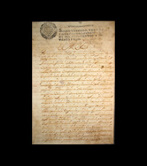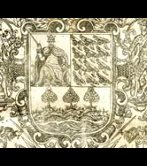Compiling of provincial laws, 1696
Compilation, confirmation and publication: these were the provincial government’s three objectives when it printed its compendium of provincial laws and regulations in the late 17th century. This culminated the series of documents that had commenced in the 14th century with the old Cuadernos de Hermandad (a collection of mediaeval laws and bylaws).
The task of updating the provincial bylaws had been in progress throughout the entire 16th century, though without reaching the perfection or utility desired by the members of the regional government. This was the case, for example, with the compiling project presented to Bachiller Zaldibia, and later to Zandategi and Cruzat, in 1583. However, the project that was directed by the latter two was utilised as the legal base to which new regulations were added during the 17th century. All these corrections and innovations (some of them very different to the originals) had to be approved by the Corregidor, and finally, on 3rd April 1696, Carlos II signed the definitive authorisation to print the compilation that had been completed by Tolosa-born Miguel Aranburu. This process, however, was neither linear nor was it without reservations and unexpected incidents.
The 1696 edition brought to an end a process, the final part of which had commenced in 1681 when Aranburu received the commission from the Junta to draft, firstly, an inventory of the provincial archives and then, in 1685, to compile and organise all the previous bylaws. Since 1691, the Juntas had been debating whether to continue using this compilation (as they had been doing with the 1583 edition) or to formally print it. This second option presented two solutions: either printing it without royal permission, or applying for said permission, which carried the risk that they might be denied a licence to print or – worse still – that part or all of the contents might be called into question. On the other hand, printing with a licence would grant it greater legitimacy and legal force. In the end, an application was submitted for a licence, and the Consejo Real passed the matter over to the Corregidor, Juan Antonio de Torres who, advised by Aranburu, took a year to check the veracity and suitability of the documentation.
Aranburu continued to carry out tasks of coordination and intermediation between all the political bodies and representatives involved in monitoring the correction of texts and their "legality". And, most importantly, he also achieved – through the aforementioned licence – the legal authority to ensure that the province would own the publication in exclusivity for a period of 10 years.
The task of printing fell to Bernardo de Ugarte, aided by two officials and, though he worked at a reasonable speed, his progress was hampered by difficulty in achieving a supply of paper: they had to go all the way to Bordeaux at the height of war to get it. The work was carried out under the direct supervision of Aranburu, in whose house the printer was obliged to work. The initial plan envisaged a print run of 3,000 bound copies. Though the printing was a victory for the province, as it complied with its political and organisational objectives, it was not good business economically speaking. Even though good sales had been expected in Seville, Cádiz and America (key sites of Basque and Guipuzcoan emigration) by late 1697, more than half of the copies remained unsold.
The New Compilation did not have to wait long to endure its first trial by fire: the dynastic change and reticence of the Bourbons. Thus in 1704, the public prosecutor of the Consejo Real did not appear to be very much in agreement with several of the regulations included in the text, especially those concerning customs duties; however, given the province's favourable status and the fact that it had given military aid to the new dynasty in the War of Succession, finally the confirmation was granted, accompanied by the postscript (used from 1702 onwards) "without detriment to our royalties and royal patrimony”,.




